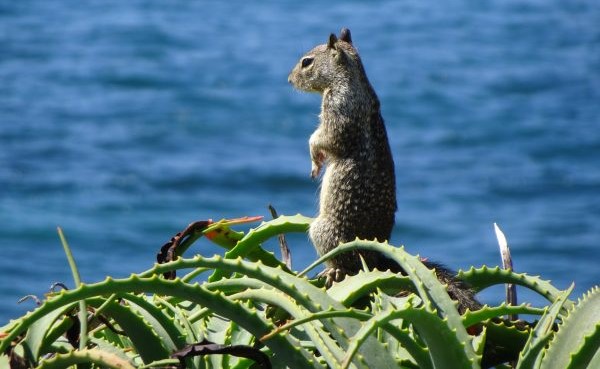Love them or hate them, squirrels have been known to frequent the bluffs near La Jolla beaches.
But some residents are raising concerns about the use of poisonous chemicals to address what the city of San Diego calls “overpopulation” of “very invasive” squirrels in the Windansea area.
“In California, ground squirrels in park areas can wreak havoc on natural habitat and park facilities,” said city spokesman Benny Cartwright. “As members of the rodent family, they can contain vector diseases and hamper or halt the establishment of plant material. … [They also] burrow into fragile bluffs, causing destabilization and erosion.”
But residents such as Molly Bowman-Styles feel the animals contribute to the overall enjoyment of the beach.
Bowman-Styles said she was used to seeing a family of squirrels on her morning walks with her dog and was dismayed when they disappeared.
“I sensed something was wrong [in late June] when a squirrel family who lived in a lush bush near the stairs at the end of Nautilus Street vanished one morning,” she said.
Weeks before, Bowman-Styles said, “five baby squirrels emerged from the bush and began exploring their new surroundings. They climbed branches, sampled the flowers in their tiny paws and played together.”
When the group of squirrels disappeared, some residents became concerned that they may have been killed through use of poisonous chemicals as part of the city’s effort to reduce the number of rodents that can carry diseases transmitted to humans or animals through a bite.
Cartwright said the city Parks & Recreation Department has a certified vendor “to identify areas of overpopulation and to perform the necessary abatement services as needed.”
Methods include a combination of techniques including habitat modification and, “when population numbers require it, eradication,” he said.
The use of chemicals, he added, is considered only “when other options have been exhausted.”
All city staff members who perform grounds maintenance are trained in integrated pest management, a strategy for “the long-term management of the equilibrium in our environment,” Cartwright said.
“The city chooses qualified contractors to maintain healthy population numbers,” he added. “Vendors use chemicals approved by the U.S. Environmental Protection Agency that have been reported safe to use in California. The Parks & Recreation Department is constantly being monitored by both the [state] Department of Pesticide Regulation and the county agriculture department to ensure compliance with the proper use of each chemical.”
Cartwright did not immediately answer questions from the La Jolla Light about how the chemicals are administered, how they kept away from other animals and whether they are used in other areas of La Jolla.
Bowman-Styles argued that “there must be a more humane way to ward off cliff erosion.”
She also contended that human activity is responsible for damaging the bluffs, including “running and walking up and down the cliffs as opposed to using the stairs, and dragging heavy wagons filled with beach gear down to the beach on unmarked trails.”
“Killing squirrels with poison,” she added, “not only is dangerous to the poor squirrels, it’s also hazardous to birds, other wildlife and dogs who might come in contact with the poisoned carcasses.
“I’m sure poisoning the squirrels of Windansea is the city’s most cost-effective option, but it’s also the most cruel and inhumane.” ♦
